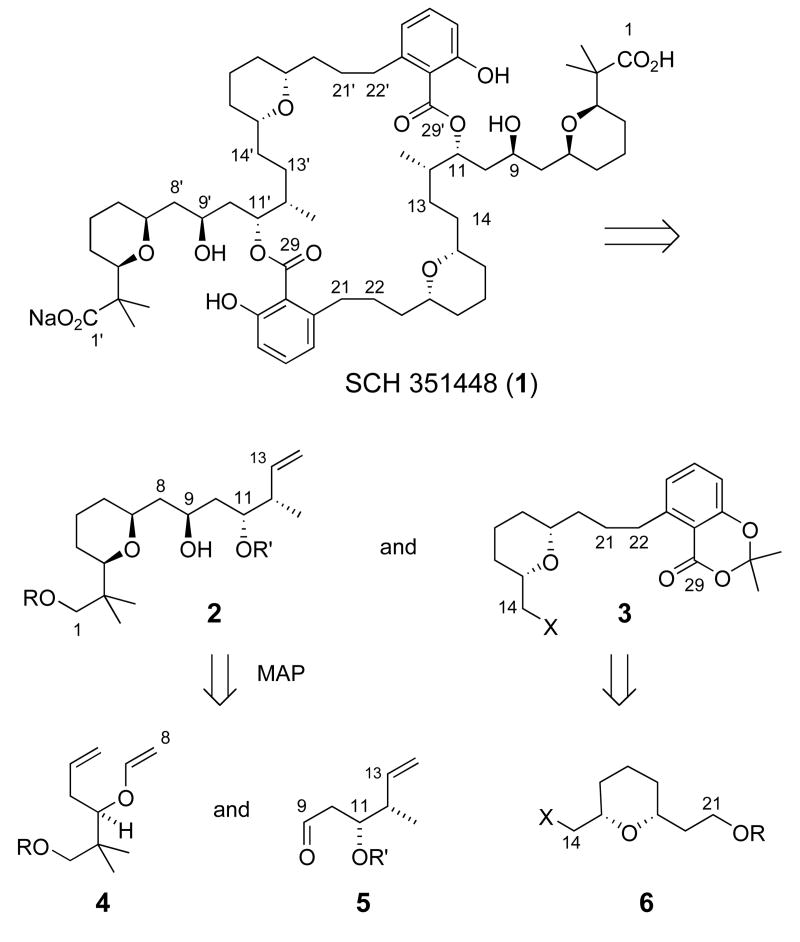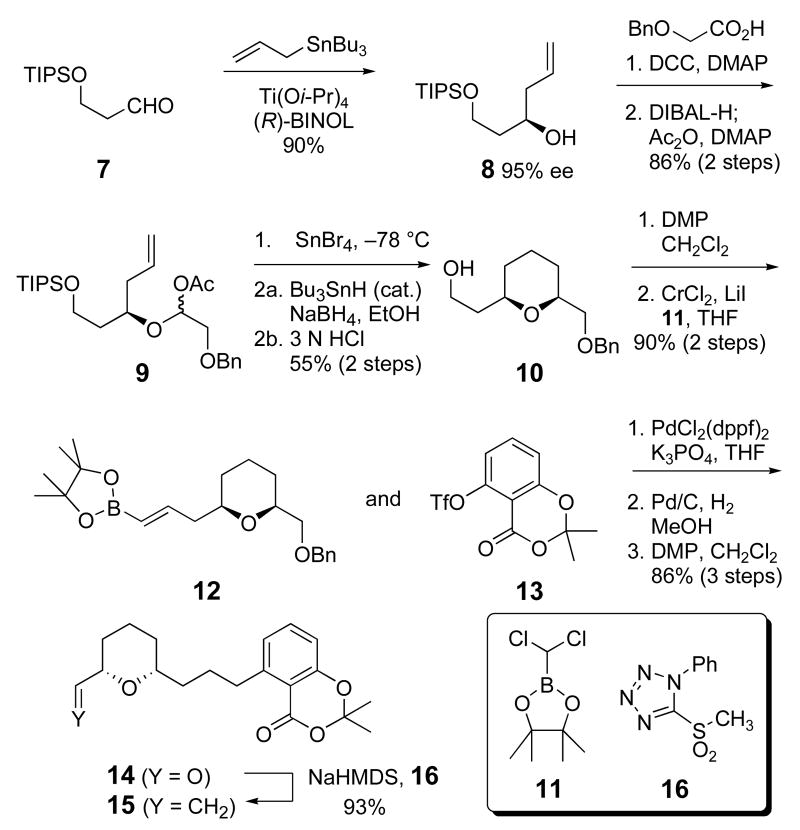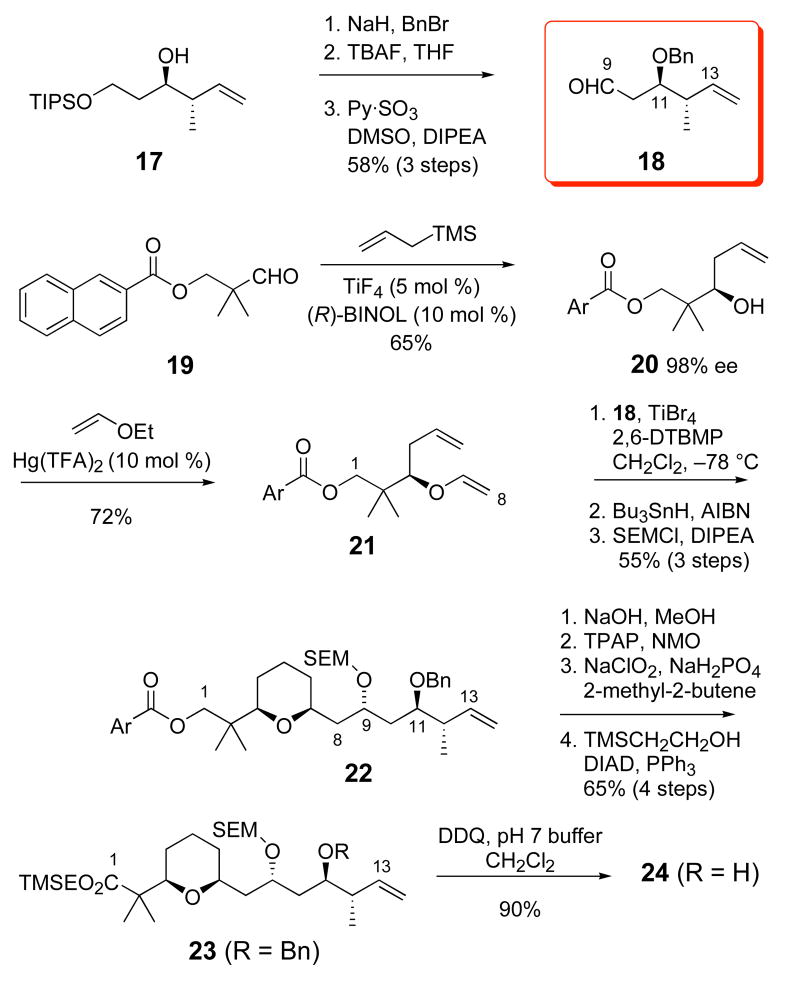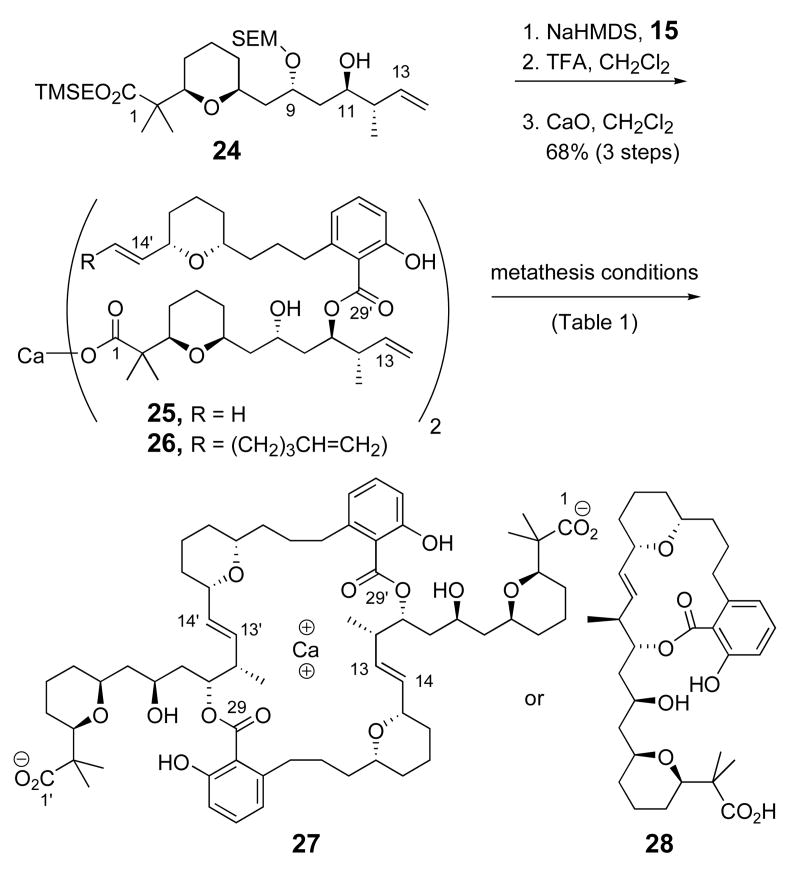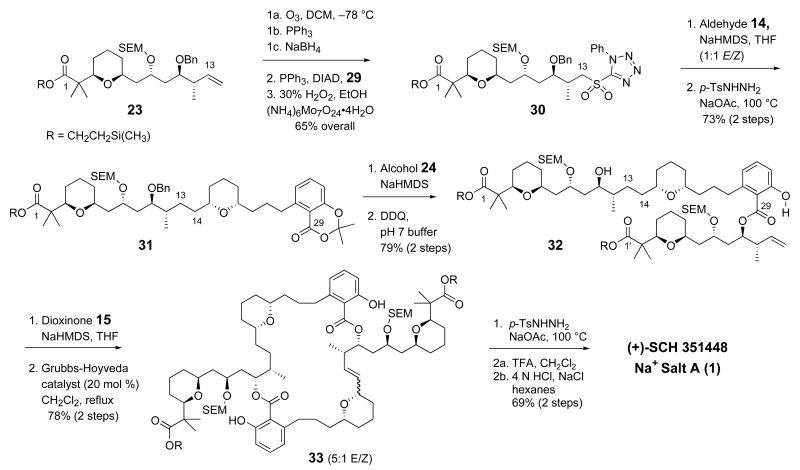Abstract
The synthesis and absolute configuration of SCH 351448, an interesting ionophoric natural product, are reported herein. Mukaiyama aldol-Prins and segment-coupling Prins reactions were employed to construct the constituent tetrahydropyrans of SCH 351448. Efforts to assemble the C2-symmetric core of the natural product by a templated olefin metathesis strategy are described, however, a stepwise fragment assembly was ultimately utilized to complete the target molecule.
In 2000, Hegde and coworkers from Schering-Plough Research Institute and Duke University reported the isolation of the dimeric sodiated polyketide SCH 351448 (1) from an unspecified Micromonospora sp.1 Compound 1 was found to be a selective activator of the low-density lipoprotein receptor (LDLR) promoter, a genetic sequence responsible for modulating expression of the surface receptor for LDL. Increased expression of LDLR has been shown to decrease blood serum cholesterol levels, thereby offering a potential therapy for hypercholesterolemia.2
Compound 1 is the only known small molecule activator of the LDLR promoter and has drawn appreciable scrutiny, as evinced by several total3,4,5,6 and partial7,8 syntheses of the (+)-enantiomer. In addition to completing the first total synthesis, Lee noted the high binding affinity of compound 1 for Ca2+ ion at near-physiological pH. This affinity for calcium may be pertinent to the biological activity of compound 1.9 We report a new synthesis of compound 1 using Mukaiyama aldol-Prins (MAP) and segment-coupling Prins reactions to prepare the constituent tetrahydropyrans. Furthermore, we have determined the heretofore unknown absolute stereochemistry of the natural enantiomer.
The monomeric subunits of compound 1 were dissected into the tetrahydropyranyl fragments 2 and 3 (Figure 1). Fragment 2 would be prepared by a MAP reaction between the homoallylic enol ether 4 and aldehyde 5.10 Fragment 3 would be derived from tetrahydropyran 6, which would be prepared by segment-coupling Prins reaction.11 Departing from other reported strategies, we envisioned that a one-pot cross-metathesis/ring-closing metathesis (CM/RCM) event would unite two identical C1–C29 monomers and form the macrocycle of compound 1.12 The appropriate chemo- and regioselectivities would be dictated by a Ca2+ template12c in the dimerization/macrocyclization cascade.
Figure 1.
Retrosynthetic analysis of SCH 351448 (1)
Synthesis of the C14–C29 fragment of compound 1 began with asymmetric allylation13 of aldehyde 714 to yield alcohol 8 (Scheme 1). Conversion of alcohol 8 to α-acetoxy ether 9, followed by segment-coupling Prins reaction with SnBr4, furnished an epimeric mixture of C17-bromotetrahydropyrans, which was homogenized into alcohol 10. Oxidation of alcohol 10 to an intermediate aldehyde and subsequent olefination through Takai's procedure provided vinyl boronate 12.15 Suzuki coupling of vinyl boronate 12 with aryl triflate 1316 provided a provisional C14–C29 segment containing a benzyl ether and an E-alkene. Hydrogenation revealed a primary alcohol that was later oxidized to aldehyde 14. Julia-Kocieński olefination of aldehyde 14 gave alkene 15.3 Both aldehyde 14 and alkene 15 were used in subsequent studies.
Scheme 1.
Synthesis of tetrahydropyranyl fragments 13 and 14
Synthesis of the C1–C13 fragment of compound 1 began with alcohol 17,17 prepared by asymmetric crotylation18 of aldehyde 7 (Scheme 2). Benzyl ether formation, TIPS deprotection, and oxidation provided aldehyde 18, the electrophilic component for the MAP reaction. Asymmetric allylation19 of aldehyde 19 furnished alcohol 20. Vinyl exchange20 catalyzed by Hg(TFA)2 converted alcohol 20 to homoallylic enol ether 21, the nucleophilic component for the MAP reaction.
Scheme 2.
Synthesis of the C1-C13 ester 22 using a Mukaiyama aldol-Prins reaction
Enol ether 21 and aldehyde 18 were subjected to TiBr4-promoted MAP reaction in the presence of 2,6-di-tert-butylmethylpyridine (2,6-DTBMP), a hindered base, at –78 °C (Scheme 2). The resultant adduct was isolated in 76% yield as a mixture of C9,C11-anti/syn epimers favoring the desired anti disposition by ca. 3:1. The superfluous bromide was removed by radical-mediated reduction and the C9,C11-anti/syn epimers were separated by flash chromatography. The C9 alcohol was protected as the SEM ether 22. Hydrolysis and a stepwise oxidation of intermediate 22 gave the acid, which was protected as a TMSE ester 23 by Mitsunobu reaction. DDQ deprotection of benzyl ether 23 yielded alcohol 24, poised for coupling.
To expedite macrodiolide formation, an ion-templated CM/RCM cascade was examined (Scheme 3). We proposed that a Ca2+ complex comprised of two monomeric ligands would be predisposed toward a synthetically convergent dimerization/cyclization cascade. Hence, alcohol 24 was esterified with the dioxinone of alkene 14. Global deprotection with TFA furnished the free acid, which was then treated with stoichiometric CaO in CH2Cl2 to yield Ca2+ salt 25.21 Unfortunately, treatment of salt 25 with a variety of metathesis catalysts22 never led to the dimeric product 27 (Table 1). The CM/RCM cascade was further attempted using Hoye's relay tactic23 to ensure alkene activation, but substrate 26 led only to compound 25 upon treatment with metathesis catalysts. While these experiments confirmed that substrate 26 underwent relay metathesis to extrude cyclopentene, the resultant ruthenium-alkylidene funneled to the unreactive complex 25. After these disappointing results, we redirected our efforts to a more conventional strategy for completing the synthesis of compound 1.
Scheme 3.
Attempted Template-Directed CM/RCM to Form Macrodiolide Chelate 27 from Ca2+ salts 25 and 26
Table 1.
Screen of Conditions for Templated CM/RCM
| substrate | catalysta | conditionsb | outcomec |
|---|---|---|---|
| 25 | Grubbs I | 23 °C, 12 h | 25 |
| 25 | Grubbs I | 60 °C, 6 h | 25 + 28 |
| 25 | Grubbs II | 23 °C, 12 h | 25 |
| 25 | Grubbs II | 60 °C, 8 h | 25 + 28 |
| 25 | Grubbs-Hoveyda | 45 °C, 8 h | 25 |
| 25 | Grubbs Variantc | 45 °C, 8 h | 25 |
| 26 | Grubbs II | 23 °C, 12 h | 25 |
| 26 | Grubbs-Hoveyda | 23–45°C, 12 h | 25 |
For the catalyst structures, see reference 21.
All reactions were run in CH2Cl2.
All reactions were monitored by mass spectrometry.
The sequence that ultimately proved fruitful mirrored Lee's route to the macrocycle of compound 1 (Scheme 4). Ozonlysis of the terminal alkene in THP 23 followed by reductive workup provided an intermediate alcohol, which was substituted with 1-phenyl-1H-tetrazol-5-thiol (29) and then oxidized to sulfone 30. Julia-Kocieński coupling with aldehyde 14 using NaHMDS gave an inconsequential 1:1 E/Z mixture of alkenes, which was reduced with diimide to furnish dioxinone 31. Esterification with alcohol 24 and subsequent benzyl deprotection with DDQ gave the alcohol 32. Esterification with dioxinone 15 afforded the acyclic diene, which underwent ring-closing metathesis upon treatment with the Grubbs-Hoveyda catalyst to produce macrocycle 33 in 93% yield. Diimide reduction, global deprotection, and metallation delivered SCH 351448 (1) as the (+)-enantiomer of sodium salt A described by Lee.
Scheme 4.
Assembly of (+)-SCH 351448 (1) by Sequential Esterification and RCM
The absolute configuration of the natural enantiomer of compound 1 had remained unknown. Through the generous gift from the Schering-Plough Research Institute of an authentic sample of compound 1, the absolute configuration of the natural product could then be established Proton and carbon data for synthetic 1 (sodium salt A) were identical to that reported for the natural product.1 The specific rotations of the synthetic and natural compounds 1 (sodium salts A) were both positive.24 Because of the limited quantity of authentic material, the identity of natural and synthetic (+)-SCH 351448 was further confirmed by comparison of their CD spectra.25
The synthesis of (+)-SCH 351448 was achieved by using MAP and segment-coupling Prins reactions to construct the two pairs of THPs. A templated CM/RCM cascade proved to be a nonviable strategy, and thus the macrodiolide was assembled by iterative esterifications followed by RCM. The absolute configuration of natural SCH 351448 was determined to be identical to that of the (+)-enantiomer. This synthesis illustrates the utility of Prins cyclizations in natural product synthesis.
Supplementary Material
Supporting Information Available: Characterization data and experimental procedures for all compounds described are included. This material is available free of charge via the Internet at http://pubs.acs.org.
Acknowledgments
This work was supported by the National Institute of General Medical Sciences (GM-43854). We would like to thank Dr. Vinod Hegde and the Schering-Plough Research Institute for providing us with an authentic sample of SCH 351448.
Footnotes
This paper is dedicated to Professor Madeline Joullié at the University of Pennsylvania for her inspirational and unwavering commitment to chemical research and education.
References
- 1.Hegde VR, Puar MS, Dai P, Patel M, Gullo VP, Das PR, Bond RW, McPhail AT. Tetrahedron Lett. 2000;41:1351–1354. [Google Scholar]
- 2.a Brown MS, Goldstein JL. Science. 1986;232:34–47. doi: 10.1126/science.3513311. [DOI] [PubMed] [Google Scholar]; b Brown MS, Goldstein JL. Cell. 1997;89:331–340. doi: 10.1016/s0092-8674(00)80213-5. [DOI] [PubMed] [Google Scholar]
- 3.a Kang EJ, Cho EJ, Lee YE, Ji MK, Shin DM, Chung YK, Lee E. J Am Chem Soc. 2004;126:2680–2681. doi: 10.1021/ja0315309. [DOI] [PubMed] [Google Scholar]; b Kang EJ, Cho EJ, Ji MK, Lee YE, Shin DM, Choi SY, Chung YK, Kim JS, Kim HJ, Lee SG, Lah MS, Lee E. J Org Chem. 2005;70:6321–6329. doi: 10.1021/jo0507993. [DOI] [PubMed] [Google Scholar]
- 4.Soltani O, De Brabander JK. Org Lett. 2005;7:2791–2793. doi: 10.1021/ol0510769. [DOI] [PubMed] [Google Scholar]
- 5.Bolshakov S, Leighton JL. Org Lett. 2005;7:3809–3812. doi: 10.1021/ol0515006. [DOI] [PMC free article] [PubMed] [Google Scholar]
- 6.Crimmins MT, Vanier GS. Org Lett. 2006;8:2887–2890. doi: 10.1021/ol061073b. [DOI] [PubMed] [Google Scholar]
- 7.Backes JR, Koert U. Eur J Org Chem. 2006:2777–2785. [Google Scholar]
- 8.Chan KP, Ling YH, Loh TP. Chem Commun. 2007:939–941. doi: 10.1039/b616558c. [DOI] [PubMed] [Google Scholar]
- 9.Dolmetsch RE, Pajvani U, Fife K, Spotts JM, Greenberg ME. Science. 2001;294:333–339. doi: 10.1126/science.1063395. [DOI] [PubMed] [Google Scholar]
- 10.a Kopecky DJ, Rychnovsky SD. J Am Chem Soc. 2001;123:8420–8421. doi: 10.1021/ja011377n. [DOI] [PubMed] [Google Scholar]; b Patterson B, Marumoto S, Rychnovsky SD. Org Lett. 2003;5:3163–3166. doi: 10.1021/ol035303n. [DOI] [PubMed] [Google Scholar]; c Patterson B, Rychnovsky SD. Synlett. 2004:543–545. [Google Scholar]; d Van Orden LJ, Patterson BD, Rychnovsky SD. J Org Chem. 2007;72:5784–5793. doi: 10.1021/jo070901r. [DOI] [PMC free article] [PubMed] [Google Scholar]; e Gesinski MR, Van Orden LJ, Rychnovsky SD. Synlett. 2008:363–366. doi: 10.1055/s-2008-1032053. [DOI] [PMC free article] [PubMed] [Google Scholar]
- 11.Rychnovsky SD, Hu YQ, Ellsworth B. Tetrahedron Lett. 1998;39:7271–7274. [Google Scholar]
- 12.For examples of ion-templated metathesis, see: Mohr B, Weck M, Sauvage JP, Grubbs RH. Angew Chem, Int Ed Engl. 1997;36:1308–1310.Ng KY, Cowley AR, Beer PD. Chem Commun. 2006:3676–3678. doi: 10.1039/b606503a.Akine S, Kagiyama S, Nabeshima T. Inorg Chem. 2007;46:9525–9527. doi: 10.1021/ic701585x.
- 13.Keck GE, Tarbet KH, Geraci LS. J Am Chem Soc. 1993;115:8467–8468. [Google Scholar]
- 14.Wipf P, Graham TH. J Am Chem Soc. 2004;126:15346–15347. doi: 10.1021/ja0443068. [DOI] [PubMed] [Google Scholar]
- 15.Takai K, Kunisada Y, Tachibana Y, Yamaji N, Nakatani E. Bull Chem Soc Jpn. 2004;77:1581–1586. [Google Scholar]
- 16.Fürstner A, Konetzki I. Tetrahedron. 1996;52:15071–15078. [Google Scholar]
- 17.a Dreher SD, Leighton JL. J Am Chem Soc. 2001;123:341–342. doi: 10.1021/ja0035102. [DOI] [PubMed] [Google Scholar]; b La Cruz TE, Rychnovsky SD. Org Lett. 2005;7:1873–1875. doi: 10.1021/ol050589c. [DOI] [PubMed] [Google Scholar]
- 18.Bhat KS, Brown HC. J Am Chem. 1986;108:5919–5923. doi: 10.1021/ja00279a042. [DOI] [PubMed] [Google Scholar]
- 19.Bode JW, Gauthier DR, Jr, Carreira EM. Chem Commun. 2001:2560–2561. [Google Scholar]
- 20.Gurjar MK, Krishna LM, Reddy BS, Chorghade MS. Synthesis. 2000:557–560. [Google Scholar]
- 21.The most drastic change upon formation of calcium salt 25 from the free acid is found in their 13C NMR spectra, wherein the signal for the C1 carbon of the acid (δ 180.8 ppm) disappears after exposure to CaO. Furthermore, there are noticeable changes in peak patterns for the 60 to 90 ppm region: the free acid exhibits six signals whereas the calcium complex 25 exhibits only five (two of the peaks have become coincident). The differences seen in the 1H NMR spectra are subtle, consisting primarily of broadening of three peaks appearing between 2.5 and 4.0 ppm. Both compounds show an identical parent molecular ion (M + Na+) by ES-MS. For references regarding NMR studies of calcium coordination complexes please see: Chen CS, Wu SH, Wu YY, Fang JM, Wu TH. Org Lett. 2007;9:2985–2988. doi: 10.1021/ol0709533.Akine S, Taniguchi T, Nabeshima T. J Am Chem Soc. 2006;128:15765–15774. doi: 10.1021/ja0646702.Akine S, Taniguchi T, Saiki T, Nabeshima T. J Am Chem Soc. 2005;127:540–541. doi: 10.1021/ja046790k.Nabeshima T, Takahashi T, Hanami T, Kikuchi A, Kawabe T, Yano Y. J Org Chem. 1998;63:3802–3803.
- 22.Stewart IC, Ung T, Pletnev AA, Berlin JM, Grubbs RH, Schrodi Y. Org Lett. 2007;9:1589–1592. doi: 10.1021/ol0705144. [DOI] [PubMed] [Google Scholar]; b Garber SB, Kingsbury JS, Gray BL, Hoveyda AH. J Am Chem Soc. 2000;122:8168–8179. [Google Scholar]; c Scholl M, Ding S, Lee CW, Grubbs RH. Org Lett. 1999;1:953–956. doi: 10.1021/ol990909q. [DOI] [PubMed] [Google Scholar]; d Schwab P, France MB, Ziller JW, Grubbs RH. Angew Chem, Int Ed Engl. 1995;34:2039–2041. [Google Scholar]
- 23.Hoye TR, Jeffrey CS, Tennakoon MA, Wang J, Zhao H. J Am Chem Soc. 2004;126:10210–10211. doi: 10.1021/ja046385t. [DOI] [PubMed] [Google Scholar]
- 24.Synthetic (+)-SCH 351448: [α]23D = +80 (c = 1.0, CHCl3); Natural SCH 351448: [α]23D = +26 (c = 1.0, CHCl3). Both of these rotations were obtained from newly acid-equilibrated samples (ref. 1). The reported rotation of synthetic (+)-SCH 351448 has varied from + 22.4 to + 80.0.
- 25.CD spectra are provided in the supporting information.
Associated Data
This section collects any data citations, data availability statements, or supplementary materials included in this article.
Supplementary Materials
Supporting Information Available: Characterization data and experimental procedures for all compounds described are included. This material is available free of charge via the Internet at http://pubs.acs.org.



